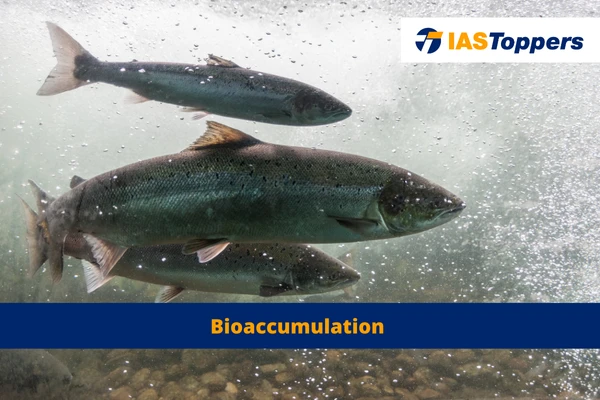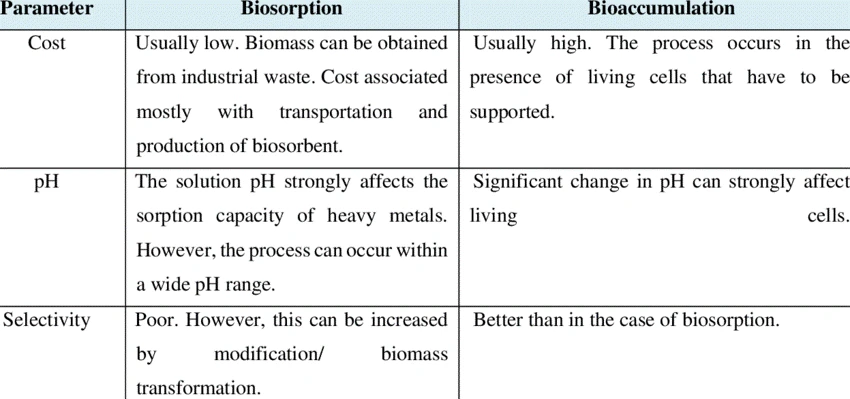Bioaccumulation refers to the gradual buildup of substances, including pesticides, plastics and other chemicals, within an organism. In this article, you will learn definition, bioaccumulation vs biomagnification, features, process, examples, factors providing key insights for GS Paper-III Environment and Ecology section of UPSC IAS Exam.
Table of Content
- Table of Content
- What is Bioaccumulation?
- Features of Bioaccumulation
- What are Persistent Chemicals?
- Factors affecting Bioaccumulation
- Examples and their harmful effects:
- Process of Bioaccumulation
- What is the difference between Bioaccumulation and Biomagnification?
- What is the difference between Biosorption and Bioaccumulation?
- Conclusion
- Frequently Asked Questions
- Reference
What is Bioaccumulation?
- Bioaccumulation refers to the gradual buildup of substances, including pesticides, plastics and other chemicals, within an organism.
Features of Bioaccumulation
- It happens when an organism absorbs a substance faster than it can eliminate it through catabolism and excretion.
- The longer a toxic substance remains in an organism’s system (its biological half-life), the higher the risk of chronic poisoning, even when the environmental levels of the toxin are relatively low.
- Biotransformation can significantly influence the bioaccumulation of chemicals within an organism.
- The toxicity associated with metals is linked to bioaccumulation and biomagnification.
- When an organism stores or absorbs a metal at a faster rate than it can metabolize and excrete it, then the metal accumulates within that organism.
- Analyzing and assessing the presence of chemicals and harmful substances in the environment helps to understand bioaccumulation, which then aids in chemical control and usage.
- Organisms can take up chemicals through inhalation, skin absorption, or ingestion.
- When the concentration of a chemical is higher within an organism than in its surroundings (air or water), it is known as bioconcentration.
- Bioaccumulation is necessary for an organism’s growth and development, but it can also lead to the accumulation of harmful substances.
What are Persistent Chemicals?
- Persistent chemicals are substances that possess high stability and do not degrade with time.
- Example: Polychlorinated biphenyl, DDT, dioxins, and mercury.
- Their inability to get degraded by environment and their dissipation is an issue.
- These chemicals can get bioaccumulated, meaning they can get increased in concentration within fish, wild game, and in human body.
Factors affecting Bioaccumulation
- Some chemicals gets attached to specific body sites, prolonging their presence, while others freely enter and exit.
- The time it takes for a chemical to be eliminated after uptake impacts bioaccumulation.
- Chemicals that are quickly eliminated, do not get accumulated in the body.
- The duration of exposure plays a role in bioaccumulation as it often gets fluctuated in concentration and duration, sometimes with periods of no exposure.
- An equilibrium is never reached, resulting in lower-than-expected accumulation.
- Bioaccumulation varies among individual organisms and species.
- Large, fatty, long-lived organisms or those with slower rates of metabolism and excretion tend to accumulate more than small, lean, short-lived organisms.
Examples and their harmful effects:
Terrestrial examples:
- The process of using mercury has led to the formation of organic compounds like methylmercury, which gets dissolved in fat and tends to accumulate in the brain, resulting in mercury poisoning.
- Similar fat-soluble toxins are tetraethyllead compounds found in leaded petrol and DDT (dichloro-diphenyl-trichloroethane).
- These substances are stored in the body fat and can cause acute poisoning when released during the breakdown of fatty tissues for energy.
- Strontium-90 is a component of atomic bomb fallout, and the radiation emitted by strontium-90 can cause long-term damage.
- Certain animal species uses bioaccumulation as a defence mechanism, by consuming toxicplants or prey, they accumulate toxins, which deters potential predators.
- Example: the tobacco hornworm concentrates nicotine to toxic levels in its body through the consumption of tobacco plants.
- The poisoning of small consumers can be transmitted along the food chain which will eventually affect higher-level consumers.
- Compounds not considered toxic may also get accumulated in organisms at harmful levels such as vitamin A concentration in the livers of carnivores such as polar bears.
Aquatic examples:
- Coastal creatures like the smooth toadfish and Atlantic puffin easily gets accumulation of heavy metals in their body.
- Methylmercury is a toxic substance which enters freshwater systems through industrialemissions and rain.
- As it moves up the food chain, its concentration increases and poses a threat to both fish and humans who rely on fish as a source of food.
- While evaluating the bioaccumulation in fish, assessments are conducted when they have been exposed to chemicals present in the water.
- Commonly tested fish species include the common carp, rainbow trout, and bluegill sunfish.
- Fish generally encounter organic chemicals in the environment through the uptake of water-borne chemicals by their lipid layer.
- Bioaccumulation can also occur with naturally produced toxins such as marine algal blooms– “red tides” produces toxins that gets accumulated in organisms like mussels and oysters toxic.
- Certain coral reef fish can accumulate ciguatoxin from reef algae, leading to a condition called ciguatera poisoning.
- In certain eutrophic aquatic systems, a phenomenon called biodilution takes place which is a decrease in contaminant concentration as the trophic level increases due to the high density of algae and bacteria that dilute the pollutant’s concentration.
- The acidification of wetlands can elevate the concentrations of chemicals or heavy metals, thus increasing their bioavailability to marine plants and freshwater organisms.
- Both rooted and submerged plants in these areas can be influenced by the bioavailability of metals.
Process of Bioaccumulation
- Bioaccumulation is a normal and vital process that supports the growth and well-being of organisms.
- It involves the gradual accumulation of essential nutrients, such as vitamins A, D, and K, trace minerals, and important fats and amino acids.
- The concern arises when substances gets accumulated at harmful levels in the body.
Uptake:
- “Uptake” refers to the entry of a chemical into an organism, whether through breathing, ingestion, or skin absorption, without considering its subsequent storage, metabolism, or elimination.
- The process of bioaccumulation begins when a chemical enters an organism’s cells from the surrounding environment.
- The chemicals tend to diffuse passively from areas of high concentration to areas of low concentration.
- This diffusion driven by the chemical potential, enables the chemical to move from outside the organism to the inside of an organism.
- The chemicals that do not mix well with water are referred to as lipophilic or hydrophobic.
- In either case, they can move out of water and enter the cells of an organism, where lipophilic environments exist.
Storage:
- “Storage” is the temporary deposition of a chemical in body tissues or organs.
- It may also apply to natural processes like fat storage in hibernating animals or starch storage in seeds.
- Once inside the organism, the same factors that has influenced uptake hinders the chemical’s return to the external environment.
- Certain chemicals are attracted to specific sites and are temporarily stored by binding to proteins or dissolving in fats.
- Example: Heavy metals like mercury.
- If uptake slows down, ceases, or the chemical is not tightly bound within the cell, the body can eventually eliminate it.
- Water solubility plays a crucial role in uptake and storage.
- Chemicals that are highly water soluble has a low potential for bioaccumulation unless the cells have mechanisms to retain them.
- Example: cobalt specifically binds to liver sites and gets accumulated there despite being water soluble.
- Other examples: mercury, copper, cadmium, and lead
- Storing toxic chemicals in fat reserves helps detoxify them or at least keep them away from harm.
- When an organism needs to utilize its fat reserves for energy, the stored materials may be mobilized again and reintroducing toxicity.
Elimination
- The ability of an organism to break down and/or excrete a chemical also influences bioaccumulation.
- Metabolism varies among organisms and species and depends on the characteristics of the chemical itself.
- Metabolism refers to the biological breakdown of chemicals.
- Chemicals that gets dissolved in fat but not in water gets eliminated more slowly by the body, increasing their potential for accumulation.
- Many metabolic reactions convert chemicals into more water-soluble forms called metabolites, which can be readily excreted.
- Natural pyrethrins are highly fat-soluble but easily gets degraded, resulting in no accumulation.
- Natural pyrethrins are insecticides derived from the chrysanthemum plant.
- The insecticide chlorpyrifos, which is less fat-soluble and poorly degraded, tends to easily get bioaccumulated.
What is the difference between Bioaccumulation and Biomagnification?
What is the difference between Biosorption and Bioaccumulation?
Conclusion
Bioremediation is one the best solution for removal of bioaccumulation. Bioaccumulation of toxic substance poses significant threat for all the organisms present on earth including Human. Bioaccumulation of even harmless substance such as Vitamin A can create imbalance in the body and may affect the whole food chain. Government should take appropriate efforts to stop the bioaccumulation including in dietary habits of Human through initiatives such as “One World One Health approach”.
Ref:
FAQs(Frequently Asked Questions)
What does bioaccumulation and biomagnification means?
Biomagnification refers to the process by which there is an increase in concentration of a substance, like a pesticide or heavy metals that enters the food chain and get accumulated into the tissues and organs of an organism and then subsequently moves to higher levels of food chain. Bioaccumulation refers to the gradual buildup of substances, including pesticides, plastics and other chemicals, within an organism.
Bioconcentration vs Bioaccumulation
Bioconcentration describes the accumulation of a water-borne chemical by an aquatic organism, whereas bioaccumulation covers the uptake from all environmental sources.
How does bioaccumulation affect humans?
Disruption of the nervous and endocrine systems, reproductive and developmental problems, immune system suppression, and cancer.






